on the Crown (not Netflix's), Whither Fuel, the Importance of Experience, Safety for AV Semis, Bugatti Espresso & More
Toyota’s new flagship is hybrid-only. . .McKinsey looks at liquid fuels. . .an experience metric. . .Aurora develops a fault management system. . .getting a costly espresso at a Bugatti dealership. . .Volvo XC40. . .Hyundai IONIQ 6
#hybrid #regulations
Toyota Crown in Numbers
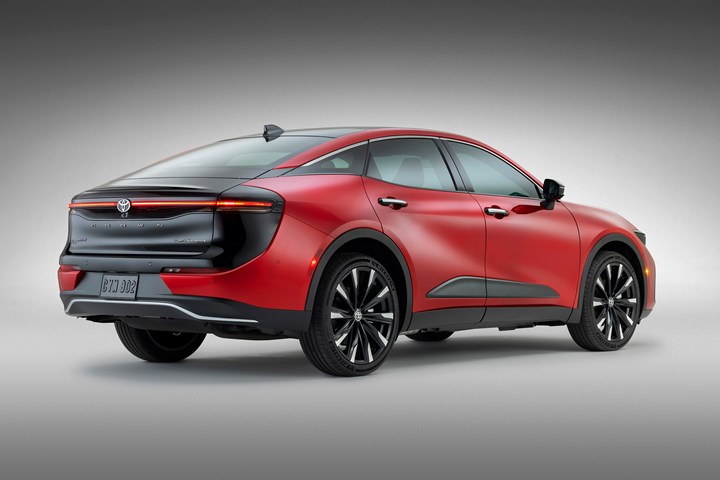
Toyota clearly wants to make a statement with its new Crown in terms of not only its available paint scheme, but because it is another hybrid-only offering in its lineup. (Image: Toyota)
The 2023 Toyota Crown is returning to the U.S. market later this year.
It is the 16th generation of the car; the first was introduced in Japan in 1955. The “Toyopet Crown,” as it was known then, was Toyota’s first mass produced passenger vehicle.
“Returning to the U.S. market?,” you think. Yes, the Crown was available in the U.S. from 1958 to 1972. You’d be forgiven not to know that.
According to Toyota, the 1965 Corona was “Toyota’s first high volume car in the U.S.” (“The what?,” you wonder. (I don’t remember it, either.) Turns out the “Corona” name is derived from the Latin for. . .Crown. The Corona was second to the Crown in the U.S. lineup.)
The 2023 Crown is available in three grades: XLE, Limited and Platinum. All have standard electronic on-demand AWD.
There are two powertrains. Both are hybrids.
The XLE and the Limited get the THS system. That’s the fourth generation Toyota Hybrid System.
As in other applications of that powertrain, there are motor-generator 1 and motor-generator 2 in the front. There is a third electric motor, this on the rear axle to provide the AWD capability. The internal combustion engine is a 2.5-liter four. Total system horsepower is 236. The THS models have an eCVT. The projected combined fuel efficiency number is 38 mpg.
The Hybrid Max system is available on the Platinum grade. It has a turbocharged 2.4-liter inline four that achieves peak torque between 2,000 and 3,000 rpm. It is mated to a six-speed automatic transmission. There are two electric motors, one in the front and a water-cooled electric axle in the rear. The net horsepower: 340. The anticipated combined fuel efficiency number is 28 mpg.
There are two AWD systems, one for the XLE and Limited and the other for the Platinum. The first is the E-Four AWD which provides a torque split of 100:0 and 20:80. The E-Four Advanced AWD on the Platinum grade allows a torque split between 70:30 and 20:80.
Although a four-door sedan, it has a somewhat crossover coupe appearance in large part because of two things: (1) the Crown, which is based on the TGNA-K architecture that underpins the Camry, has a 3.7-inch higher roofline than the Camry (60.6 inches v. 56.9 inches) and (2) the Platinum comes standard with 21-inch, 10-spoke wheels, which provides a bit of a ride-height enhancement.
(On the subject of dimensions: the Crown is 194 inches long, 72.4 inches wide and has a 112.2-inch wheelbase.)
Among the standard features are standard 8-way power adjustable driver and front passenger seats; 12.3-inch color multi-information display; Toyota Safety Sense 3.0.
There are five solid colors: Black, Oxygen White, Magnetic Gray Metallic, Heavy Metal and Supersonic Red. For the Platinum grade there is a bi-ton paint option which has black paint from the hood to the trunk with the other body panels being Oxygen White, Supersonic Red or a bi-paint only color, Bronze Age.
The Crown is the 16th available electrified vehicle in the U.S. market.
It seats five.
>>>
Peak Oil Revisited (In Effect)
Remember “peak oil,” that concept that had it that global crude production would hit its maximum and then slide down from there?
Well it seems though petroleum, particularly in relation to the auto industry, may soon be hitting something of a “peak demand.”
That according to “Global Energy Perspective 2022,” a study put out by McKinsey.
The researchers write:
“Historically, oil demand was growing by 1—2 MMb/d, half of which was through growth in road transport. While oil demand continues to recover post-COVID-19 in 2022 and 2023, the trends are projected to change from 2024 onwards The primary driver for reduced oil demand for road transport is the continued uptake of EVs.”
They explain:
- Global EV sales were up an average 62% over the past four years
- Up 96% in 2021
- EVs represented >20% of total car sales in Europe in 2021
The researchers have five scenarios in their report predicated on technological progress and policy enforcement.
Think of this as a spectrum from meh to amazing.
Four of the scenarios have “liquids demand” falling between 2024 and 2027. Only the “Fading Momentum” has it declining post-2030.
They write:
“On a regional level, liquids demand in major oil markets, such as the US and EU, has already peaked, and all markets, including developing regions such as India and Southeast Asia, are likely to peak before 2040.”
Another thing that they suggest will have a impact on road transport—sustainable fuels:
- Hydrotreated vegetable oil (HVO)
- Bioethanol
- Synthetic fuels (ammonia, methanol)
Why? Because they can be used as “drop-in fuels” in internal combustion engines.
McKinsey:
“Even though the costs of using sustainable fuels are projected to be higher than alternatives in the long term, the use of 100% renewable diesel, such as HVO, can achieve comparable lifecycle greenhouse-gas (GHG) reduction to the use of electric vehicles (EVs), allowing for faster decarbonization of existing fleets in the short term.”
Given the billions OEMs (and suppliers) have invested in ICE production capacity, sustainable fuels seem like an interesting bridge to full electrification.
>>>
It’s Not a Car: It’s an Experience

What people are increasingly concerned with when it comes to their vehicles: not miles per gallon and horsepower, but the types of “experiences” that they’ll have. (Image: EPM Advisory Council)
“Where consumers once asked ‘how fast will can I go from 0 to 60?’, they now want to know ‘how can this vehicle improve my commute’, or ‘can I access the content/info/people important to me during my time in the car?’ And, as the electrification and autonomous trends advance, it makes sense that the focus on experiences in the vehicle as opposed to what powers it will grow.”
That’s Tom Rivers, vice president, Global Automotive Marketing, HARMAN on “the Automotive EPM Index,” a metric that has been devised to allow consumers to assess a vehicle based on their “experience goals.”
EPM = Experiences Per Mile
Rivers, a founding member of the EPM Advisory Council—which has members from companies including GM, HERE Technologies, Hyundai, and Stellantis—explains, “There has been no established rating to measure the in-vehicle experience, so this way of thinking about experiences as a true value-add is new territory.”
Rivers says that the OEM members of the council are bullish on the EPM Index: “they see value in this measurement to help build their brand with new generations of consumers. . . .[T]he OEMs fully realize the need to shift emphasis from individual features and functions to more holistic experiences in order to meet their customers where they are and give them what they demand from their vehicles.”
Said another way: 0 to 60 is less important than the number of USB ports and the dimensions of the screens.
>>>
Autonomous Semis & Safety
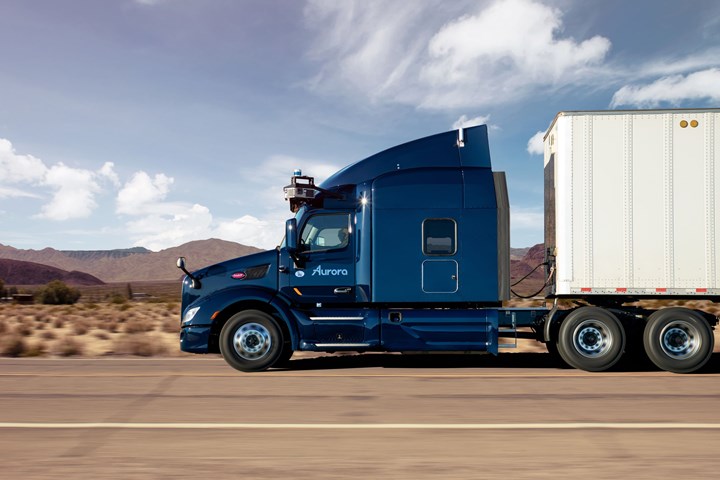
Aurora has developed a Fault Management System for its autonomous Driver: if something goes wrong, it will bring the truck to a safe place on the side of the road. (Image: Aurora)
An empty semi-truck can weigh some 35,000 pounds. Load it up with cargo and fuel and it can hit 80,000 pounds.
Which makes this statement from Sterling Anderson, chief product officer and co-founder of Aurora, a developer of self-driving technology that is working with companies including Volvo Trucks and PACCAR (yes, as in semis), all the more notable:
“Any of a number of factors, from blown tires to damaged sensors, can compromise a vehicle while on the road.”
Ah, yes. Especially if we’re talking about autonomous big rigs.
Anderson continued:
“Safely detecting and responding to those issues is essential for a reliable self-driving product operating at scale.”
Can’t argue with that.
So Aurora is developing a Fault Management System (FMS).
Last week the company announced an update to its Aurora Driver self-driving system (Beta 3.0). It includes the FMS.
The FMS monitors the health of the vehicle, including the self-driving software, sensors, and on-board computer. It can determine whether there’s been a blow out. Whether a sensor has failed.
Things you don’t want to occur.
In the event something goes awry, the truck’s hazard lights are activated, the vehicle’s speed is reduced, and the vehicle pulls to the side of the road.
Should there be a construction zone where concrete K-rails make the freeway a funnel (e.g., Michigan during the summer), an Aurora spokesperson says the FMS will drive “to the next safe place to stop or, if needed, safely slow to a stop on the road.”
Probably a good idea for something that can weigh 40,000 tons.
>>>
Bugatti & Espresso
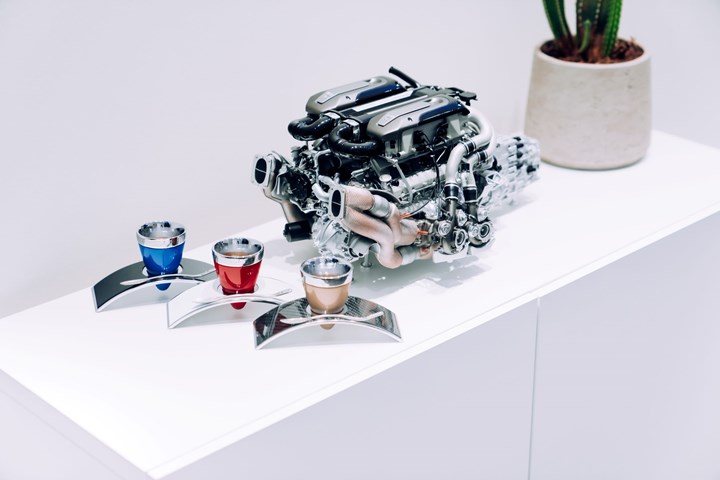
Get an espresso in a carbon fiber cup for £50 and then walk through the dealership. Hope the beverage is delicious. (Image: Bugatti)
While dealerships and coffee establishments are certainly part and parcel of the auto industry writ large, they tend not to be things we write about here.
Until now.
That’s because of H.R. Owen Bugatti, a car dealership in London’s Mayfair (it has been there since 1927), has opened what it claims is “the most exclusive coffee spot in London.”
In its dealership.
Apparently it is the first “Bugatti dealership anywhere in the world to have its own espresso bar.”
(I remember back in the day when the local Saturn dealership had a popcorn machine. . . .)
OK, it isn’t all about the fact that they’re serving various coffee beverages in Ettore’s Espresso Bar.
Rather, it is this:
- Those ordering the Ettore Shot—a.k.a., an espresso—have it served in a carbon fiber espresso cup. It is priced at £50.
- Another benefit of getting buying that particular drink: the opportunity to go into the showroom and “see the Bugatti—on static display—up close, as well as being able to learn more about the French luxury brand through the brand ambassadors based there.”
Yes, (a) the ability to go into the showroom, (b) look at a car and (c) talk to a salesman.
Hope the beverage is good.
>>>
Technical Adjustment
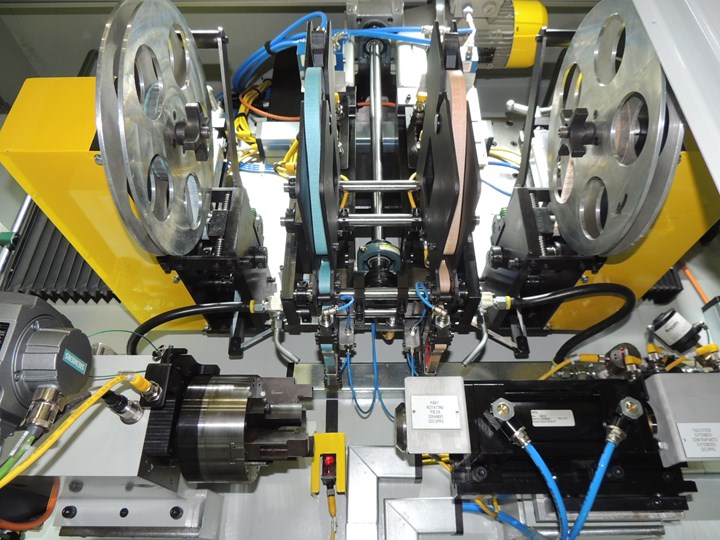
Inside an IMPCO microfinishing machine. (Image: IMPCO)
A colleague brought to my attention a company that I hadn’t thought about for, well, a few decades. IMPCO Microfinishing. The company claims to have invented “the world’s first automated crankshaft microfinishing machine in 1947.” Certainly, the tech has improved since then.
But as the name of the company indicates, it still makes microfinishing machines, which can remove as little as 10 microns from the surface of a part to reduce friction and improve functionality.
Then & Now
- That first microfinishing machine was built for a Chrysler V8.
- The parts typically processed today are things like crankshafts and camshafts.
As new internal combustion engine programs are not exactly burgeoning, it might seem as though the company’s historic relation with the auto industry would be drawing to a close.
Not so. Turns out that IMPCO has received a $3.5-million order from an unnamed OEM for five machines to be used on the bearing surfaces of a family of 300-mm rotor shafts for EV drivetrains.
One of the benefits of the precision surfaces on the shafts: a reduction in NVH when the motor is running. (Absent an internal combustion engine it is surprising what you hear in an EV.)
One wonders how many machinery manufacturers will be able to make the adjustment to what is increasingly becoming a new reality in the powertrain segment where V8s become increasingly rare and even sixes are scarce. . . .
>>>
2022 Volvo XC40 T5 AWD Inscription
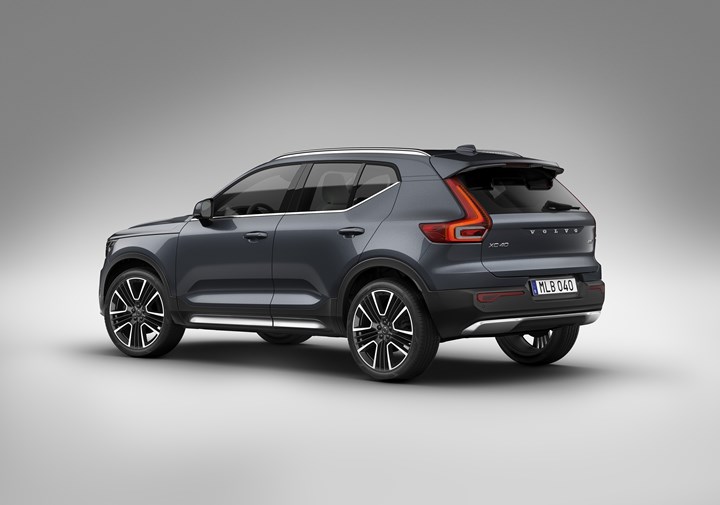
The Volvo XC40 T5. Safe, (somewhat stylish) and certainly a sporty throttle response. (Image: Volvo)
Although Polestar is now a brand that produces electric vehicles, it began its existence in 1996 as a Swedish racing team. Volvo acquired the company in 2015. Polestar’s racing-oriented engineers are still there, and in addition to still putting cars on the track (now it is known as Cyan Racing), these folks are also providing some performance enhancements for what are otherwise good, solid, sensible Swedish SUVs.
Like the XC40 in question.
Polestar brings to the XC40 things like faster throttle response and quicker gear changes. You step on the throttle and then have to glance at the badge on the steering wheel to remind you that you are in a Volvo.
That logo may be predicated on the symbol for iron, but in this case quicksilver would be a more relevant marker.
So, to the elements. . .
Power. The vehicle is powered by a 2.0-liter turbocharged engine that produces 248 hp at 5,500 rpm and 258 lb-ft of torque at 1,800 rpm.
It is equipped with an eight-speed automatic.
Setup. The suspension setup is MacPherson struts in the front and a multi-link rear.
Seats. Inside the vehicle there are comfortably bolstered leather seats that provide the right balance between a regular drive to the store and a spirited drive to somewhere.
Crystal. There are nice touches to the trim like the use of driftwood for decorative purposes. And to make sure you understand that this is a Swedish crossover, there is an Orrefors crystal shift knob.
Info. There is a 12.3-inch digital driver display (very handy when using the navigation system as the routing is also shown there) and a 9-inch touch screen for entertainment, navigation and functional (e.g., setting the temperature) purposes. The vehicle has the Volvo Sensus Connect infotainment system displayed on that screen. I’m not enthusiastic about it and I think there were some people at Volvo who agreed with me as the company is beginning to roll out vehicles with straight-up Google-powered functionality. (And while on that subject, yes the XC40 supports Android Auto and Apple CarPlay.)
Safe. What is more expected from a Volvo (this is a good reputation to have, by the way) than performance is safety, and there are an array of features ranging from low and high speed collision mitigation to a whiplash protection system for the driver and front passenger. IIHS says the XC40 is a Top Safety Pick+.
Assessment. Although Volvo is transitioning to electric powertrains, this vehicle provides more than a modicum of involuntary smile-provoking performance.
>>>
A Brief Intro to the IONIQ 6
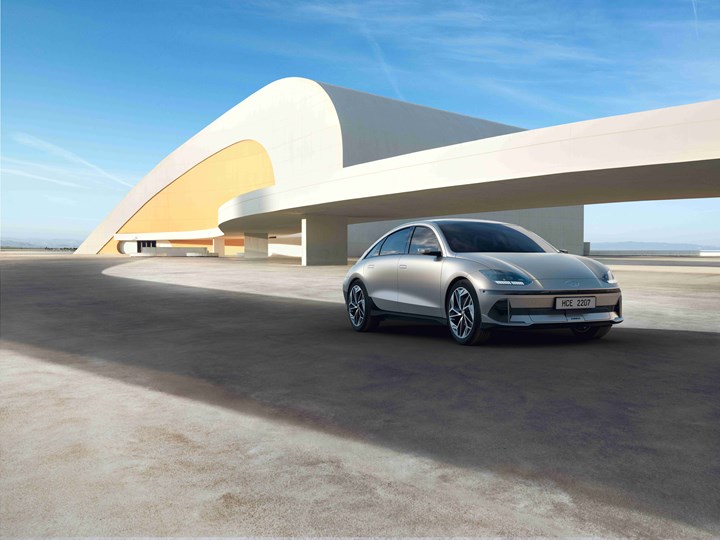
The IONIQ 6. SangYup Lee, Executive Vice President and Head of Hyundai Design Center, says of the exterior design: “This is a proportion only an EV can do, not an ICE vehicle” (Image: Hyundai)
One of the problems that the U.S. railroad industry had in the 1930s (among other things, like, oh, the Great Depression) was that passengers were abandoning trains for other forms of transportation. The automobile, in particular.
So companies including Union Pacific and Burlington decided that they needed to come up with something different to attract customers: highly styled trains. Union Pacific came out with The Streamliner. Burlington the Zephyr.
Both were highly aerodynamic and consequently had a striking presence.
Although streamliner is not a term oft-heard, Hyundai Motor Co. is brining it back, with a forthcoming electric sedan, the IONIQ 6, which it refers to as an “Electrified Streamliner.”
Or, as SangYup Lee, Executive Vice President and Head of Hyundai Design Center, puts of the development:
“The distinctive streamlined design is the result of close cooperation between engineers and designers, with obsessive attention to detail and customer-centric values at the core. We have created the IONIQ 6 as a mindful cocoon that offers personalized place for all."
The term fits
While “Electrified Streamliner” could provoke an eye roll, as one might assume that this is something of simply a marketing term, know that:
- The car has a drag co-efficient of 0.21, so if that’s not streamlined, I’d like to know what is.
- The IONIQ 6, which has an available 77.4-kWh battery, has a WLTP (that’s for “Worldwide Harmonized Light Vehicle Test Procedure”) estimated energy consumption of <14kWh/100 km, which translates into a WLTP estimated range of >610 km (>379 miles). (There is also a standard 53-kWh battery.) Yes, electrified. So 1 + 2 = this vehicle
When configured with a dual-motor setup there is a combined power output of 239 kW (320 hp) and 605 Nm of torque (446 lb-ft), which results in the possibility of going from 0 to 62 mph in 5.1 second.
Which also underlines that streamliner characteristic.
One thing that people are probably more keen on when it comes to speed is quick charging: the IONIQ 6 supports both 400-V and 800-V charging, with the latter as a standard. Hooked up to a 350-kW charger the battery can go from 10 to 80% charged in 18 minutes.
About that form factor
While it might seem odd that Hyundai is unveiling a sedan in a period when it seems that everything is all about the crossover, know that:
- Tesla is doing just fine with sedans
- Hyundai’s IONIQ 5 is a crossover
- The IONIQ 6 (like the 5) is based on the Hyundai Electric Global Modular Platform (E-GMP), so there is a whole range of configurations that can be achieved
The IONIQ 6 is going into production in Ulsan, South Korea, this quarter and is expected to arrive in U.S. showrooms early in 2023.
RELATED CONTENT
-
Paint Shop Innovations
.
-
On BMW Tech, VW Golf R Variant, Hyundai Elantra, and More
The forthcoming BMW flagship SUV—the 2022 iX xDrive50—has a lot of tech, some that is deliberately discrete. The Hawaiians spend a lot of money for gasoline and it would be less if they’d electrify. Euro drivers like wagons—and apparently extreme driving in them. Stellantis is spending big on going electric. And even more.
-
When Major Suppliers Are There It Is Real
BASF’s Coatings division to supply the surface-pretreatment and waterborne coatings for the NIO ES8, a seven-passenger electric SUV.


.jpg;width=70;height=70;mode=crop)






